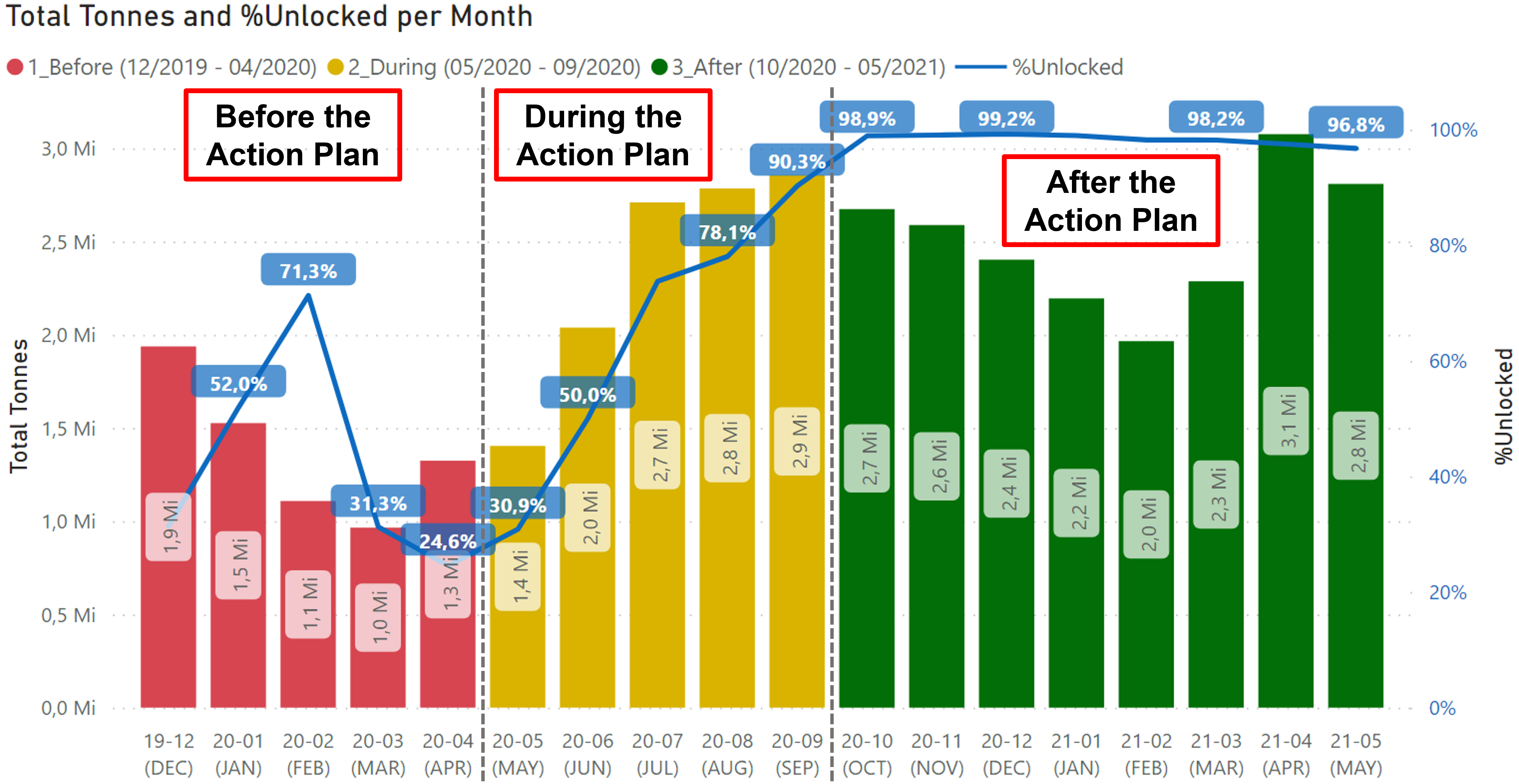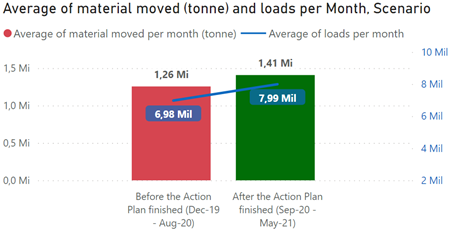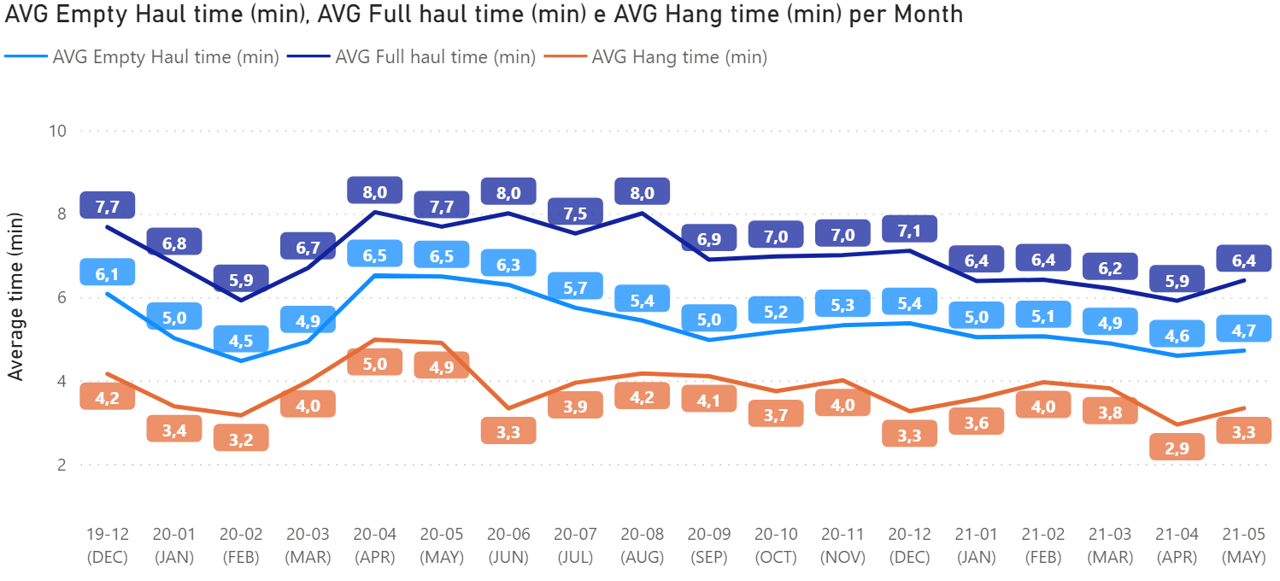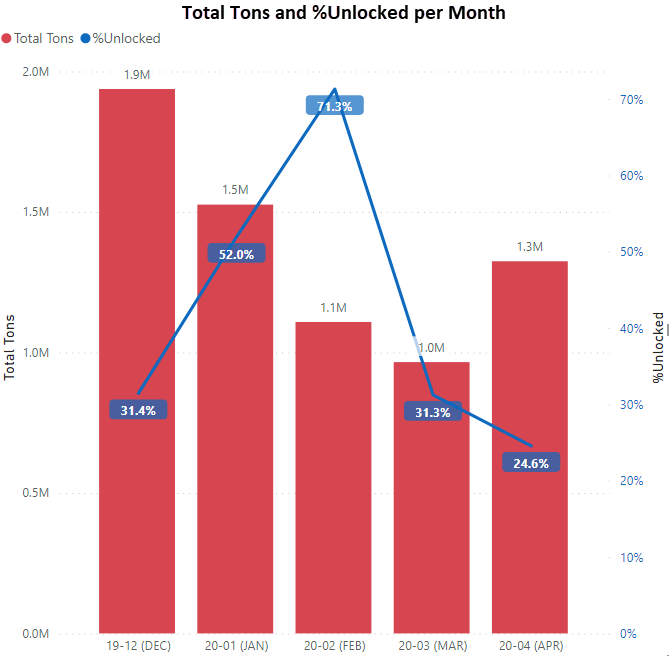DISPATCH Optimization KPI helps Brazilian iron ore mine realize an estimated USD 149M per annum in additional revenue
A large open-pit iron ore mining complex located in Minas Gerais, Brazil, operates four open pit mines and an ore beneficiation plant. In 2020, the complex produced more than 25 million tonnes of iron ore and currently utilizes Modular Mining’s DISPATCH Fleet Management System, ProVision Drill Machine Guidance and MineCare Machine Maintenance IntelliMine solutions.
LOCATION
Brazil
OBJECTIVE
Increase monthly production
OUTCOME
Monthly production increase results in an estimated revenue increase of USD12.4M per month
Challenge
In April 2020, during the Modular Mining’s Performance Assurance (PA) teams routine visit, the PA team identified that the mine was not reaching the full production capacity between December 2019 – April 2020. (Figure1). During this five-month period the mine was hauling a monthly average of 1.52 million tonnes however, based on the truck fleet capacity, the mine has the capacity to be hauling triple this at 4.5 million tonnes a month. The mine sought to increase their production by focusing on a DISPATCH optimization KPI.
The PA team identified that throughout the time period, the Optimization KPI was significantly low, reaching a minimum of 24.56% in April 2020. This resulted in 75.44% of the haulage cycles being locked. When mines lock their trucks to a shovel DISPATCH has no other option but to send these trucks to the specific shovels they are locked to. This results in the mine losing the opportunity to optimize truck loads because when trucks are unlocked, the DISPTACH algorithm calculates the best shovel assignment for each truck considering the dynamics of the mine, the amount of trucks and shovels working at the time, the operational restrictions.
Modular Mining’s PA team, together with the mines dispatch engineers investigated the following main root causes for the low performance:
• Dispatchers using too many locks and bars for haulage cycles
• Shovels and trucks not matched properly
• Road segments not updated
• Virtual beacons not working correctly
Solution
Having identified the mines root causes, the PA team implemented an action plan to increase system optimization. They planned to achieve this by deploying the following initiatives:
• Improve Shovel-Truck matching
• Review road segment data in DISPATCH MineGraphics
• Update Virtual Beacons
• Check Speed Configurations
• Review Locks and Bars for haulage cycles.
• Adoption of Lock Guidelines
• Implement Management Dashboards.
To improve the shovel-truck matching, the PA team recycled and cleaned the load factor tables in the DISPATCH system. This configuration is responsible for applying the match between shovels and trucks and in the past, it was defined by the name of the excavator. The PA team updated this so that moving forward it would be defined by the size of equipment as this would enable more productive and efficient cycles.
Several best practice recommendations were also provided during the Lock and Bar for Haulage Cycle review that outlined the benefits of operating with an unlocked system over the few PA cycles. They were validated after comparing shifts with the application of bars and shifts in which the system had full autonomy to define the best assignments.
The PA team also worked with the mine to educate the dispatch engineers on the guidelines of when locked should be applied. The development of PowerBI dashboards allowed for the monitoring and controlling of the dispatchers’ actions such as the use of locks and bars.
Results
The Action Plan was executed in May 2020 and ran for the duration of five months, ending in October 2020. Figure 2 shows that after the Action Plan had been executed (October 2020 – May 2021) the mine achieved an average of 98.4% of Optimization KPI, a 56% increase from that in April 2020.

Figure 2 – Historic – Optimization and total tons – Before, during and after the action plan

Figure 3 – Comparative scenario – Average of material moved (ton) and loads per month – Before (Dec/19-Aug/20) and after (Sep/20-May/21) the action plan (9-month interval)
On average, the mine saw a 12.14% increase (Figure 3) in material handling and a 14.61% improvement in the average number of loads each month with no significant changes in the number of trucks, shovels, and average transport distance.
The large open-pit mine also reached an average of 7.99 Mt per month during the period of September 2020 – May 2021, whereas in the previous nine-month period, was only reaching a monthly average of 6.98 Mts. The improvements on DISPATCH FMS configuration contributed to an estimated revenue increase of USD 12.4M per month1, equating to USD 149M per annum based on the 9-month before and after the action plan finished periods.
In addition to the increase in production, the implementation of the Action Plan also saw the mine achieve the following results (Figure 4):
• 16.9% reduction in full haul time (From 7.7 to 6.4 minutes)
• 23% reduction in empty haul time (From 6.1 to 4.7 minutes)
• 21.4% reduction in hang time (From 4.2 to 3.3 minutes)
This case study demonstrated how Modular’s PA Team worked in partnership with a large mine site to significantly improve its operational performance and move more material per month.

Figure 4 – Achieved goals – Cycle times per month – Dec/19 to May/21


